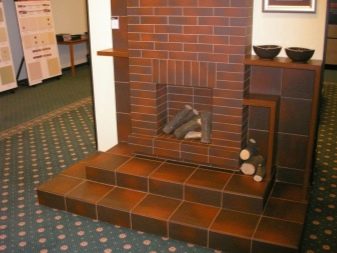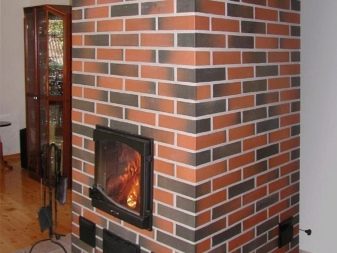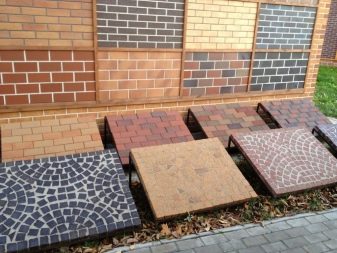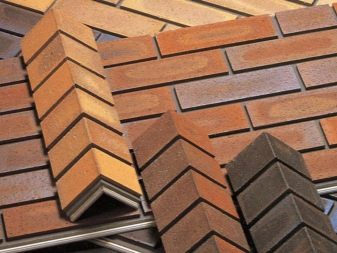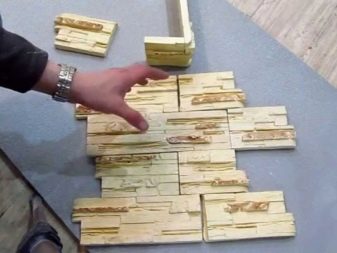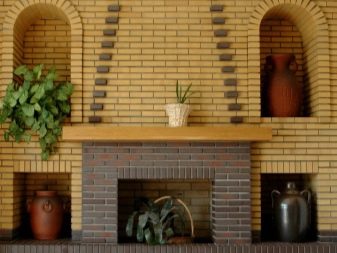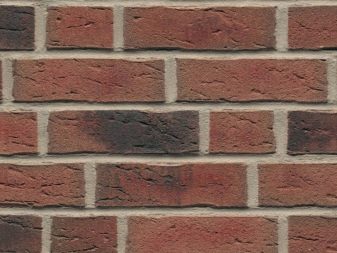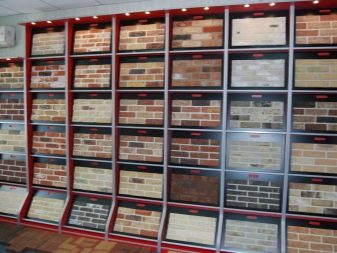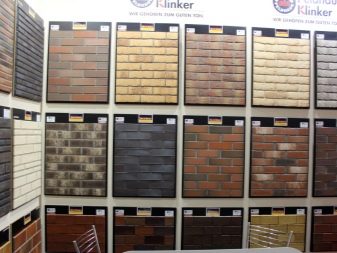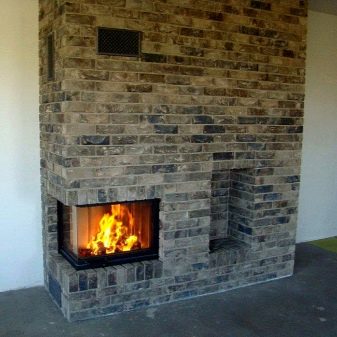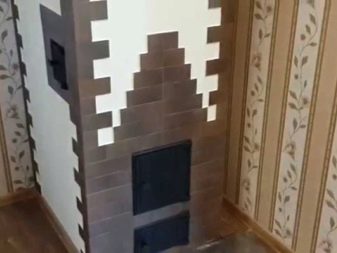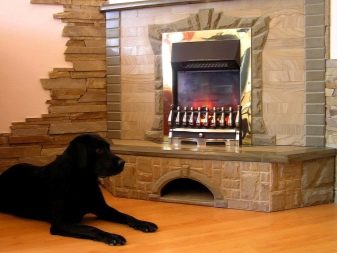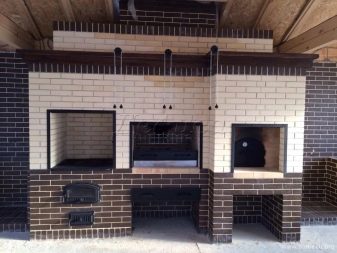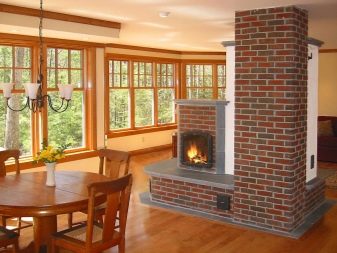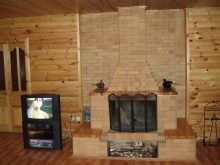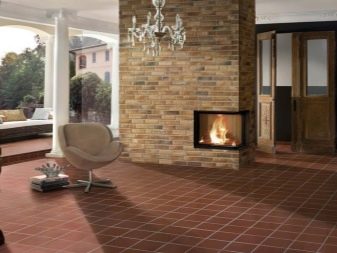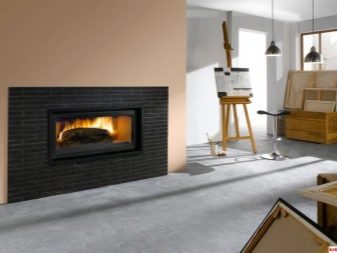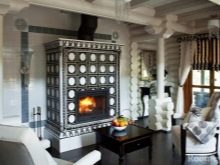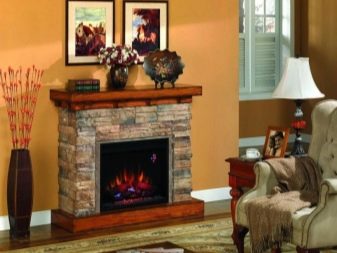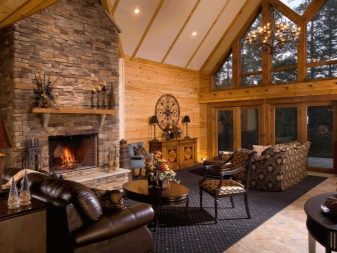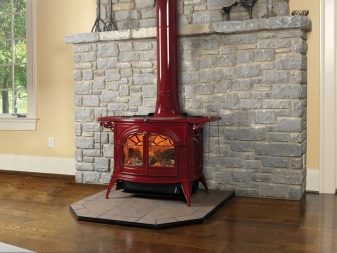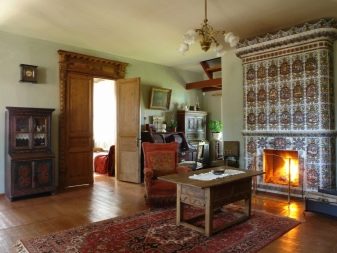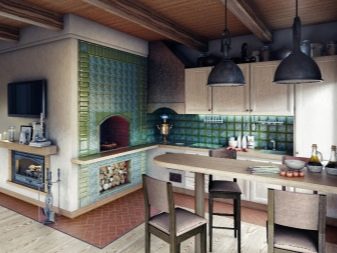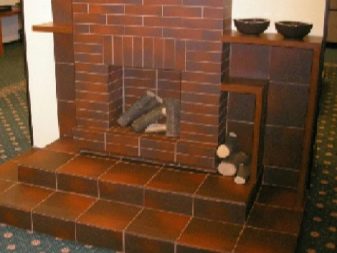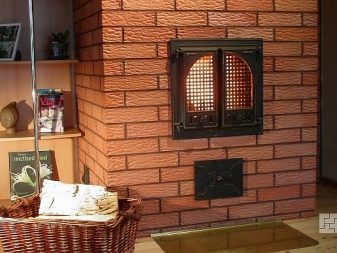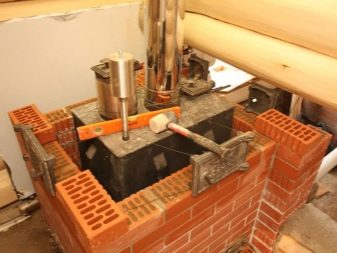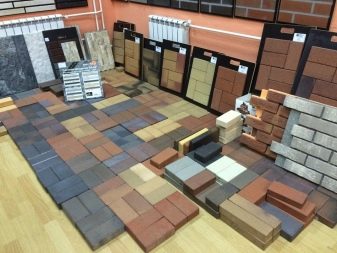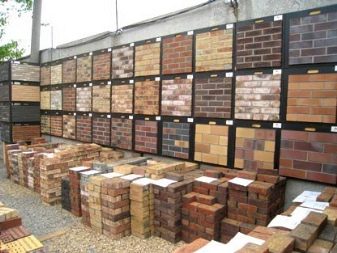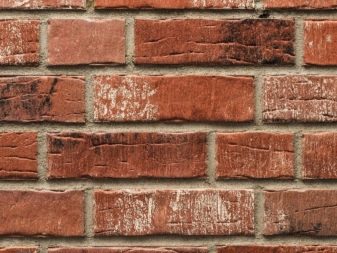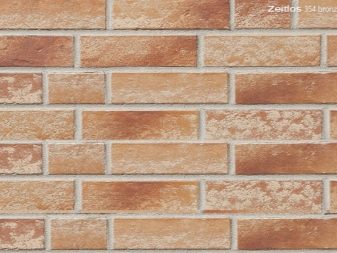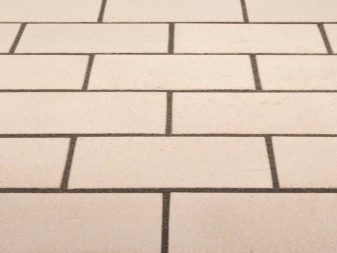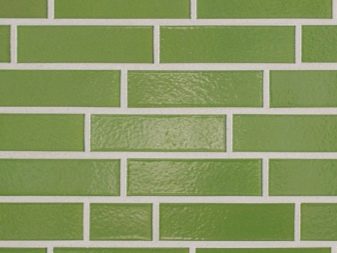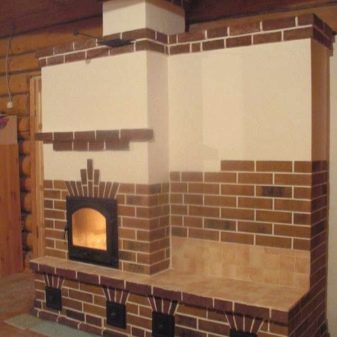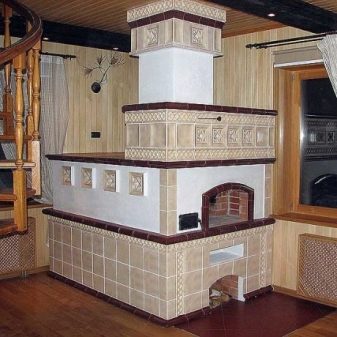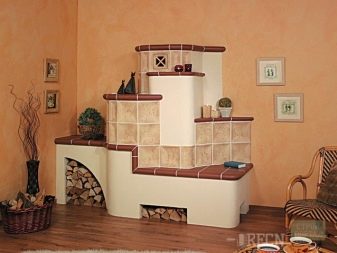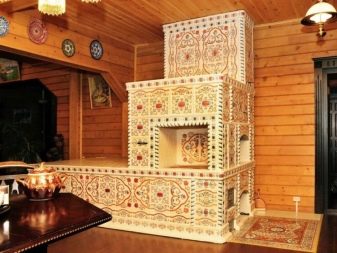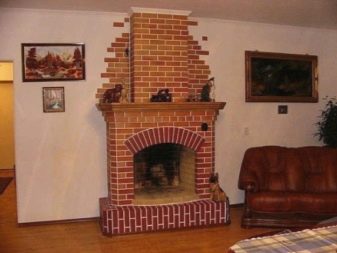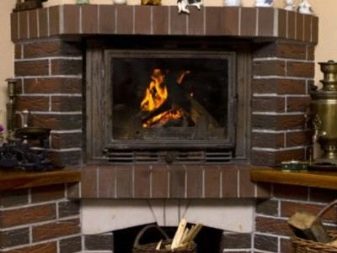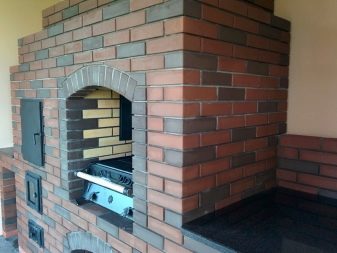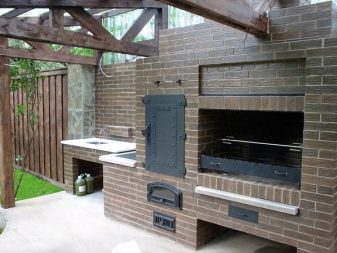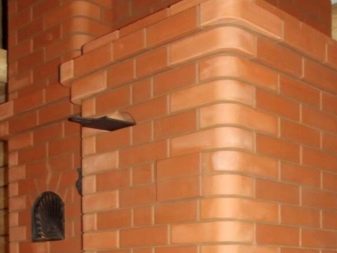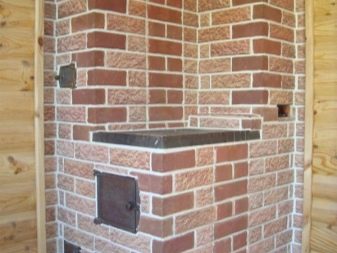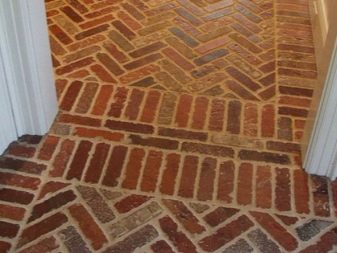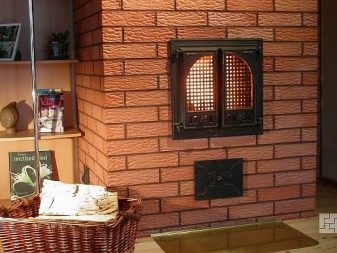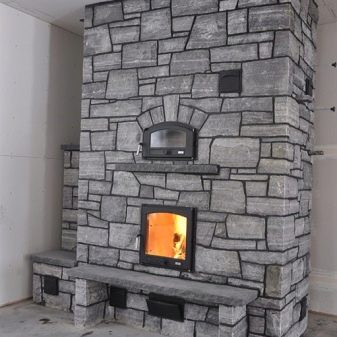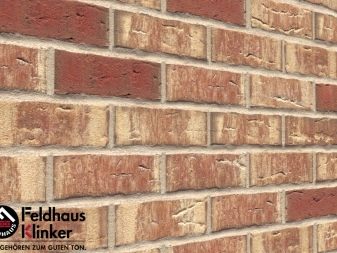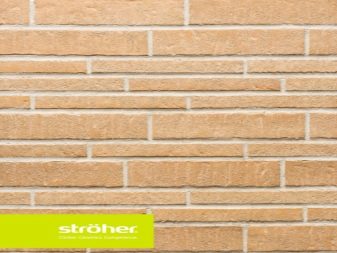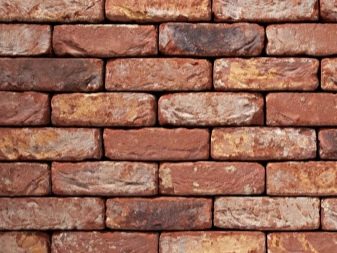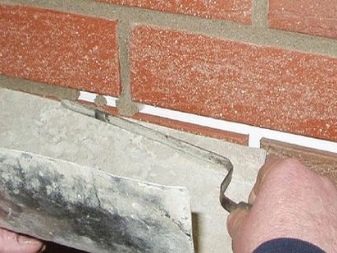Brick tiles for stoves: beautiful design options
Choosing a clinker tile, you need to know its features and design possibilities. This will make the finish as harmonious as possible. We understand together.
Composition of raw materials
Brick tile - a kind of ceramic products. Its peculiarity lies in the fact that roasting occurs at ultrahigh temperatures (from 12,000 to 15,000 degrees C). This is made possible by the special soil in the composition of clinker (shale clay), which is refractory and can withstand high heat.
Due to baking, the resulting product acquires a special strength of the stone. In addition to the refractory clay in the solution for clinker add quartz sand, pottery, chalk, and even ash.To impart additional strength, calcium oxide is sometimes mixed into the composition. In order to make the finished tile attractive externally, before painting, various coloring pigments are added to the composition.
Advantages and disadvantages
The clinker is suitable for decorating stoves or fireplaces. He has proven himself for a long time. Initially, clinker was used on the basis of practical considerations — a finish that was reliable in terms of heat resistance was needed. Today, high-quality clinker tiles are not only reliable protection, but also a successful design solution.
Consider the points of the main positive aspects of this type of finishing material:
- The clinker tile is not flammable. It is heat-resistant, has a high level of fire safety, so it can be used in places where there is an open fire (for example, a fireplace, a stove).
- Clinker is a good antistatic, it does not conduct electricity.
- This material is resistant to sudden temperature changes, it will hold out on the street during a hard frost, in a hot shop with a lot of heat.
- This tile is unpretentious in the care, it does not require much effort for cleaning, does not absorb dust, odors and moisture, is not subject to chemical attacks.
- This finish is distinguished by its extra-strength, which makes it possible not to change it for quite a long time.
- This material does not fade in the sun: clinker and after 100 years will look the same as on the first day of installation.
- The composition of this tile are exclusively natural components that do not cause side effects.
- Clinker is distinguished by a variety of shades and textures. Find the right type of material is not difficult.
- The material does not require special skills at work: even an inexperienced master will cope with the lining of the furnace wall or pipe with clinker tiles in one day.
The disadvantages of clinker include its low thermal conductivity, which can lead to slow heating of the furnace. However, such a finish will work on the principle of a thermos - the stove will cool more slowly.
In various styles
Clinker has long been deservedly popular with consumers. With this unique material, you can recreate absolutely any idea, give the room an individual design. Modern manufacturers are constantly updating collections of clinker tiles, so you can find an option for every taste and budget.Consider some key design directions where a clinker tile facing can be applied.
Minimalism
Laconic simple lines, clear geometry, preferably black and white colors are characteristic of this design. Excessive severity of the interior can be diluted with a small amount of the same heat-resistant clinker dark red or brown. This will add a bit of extravagance to the design.
Loft
Repetition of the situation of production workshops or factories. There will be appropriate models with a rough texture that mimic the brickwork, as well as other raw surfaces.
High tech
In the presence of fantasy, even an old Russian stove can be beaten in a modern interior, overlaid with clinker elements imitating a metal or chrome texture. For completeness, you can add several rows of refractory glass tiles to your design. Such a solution would be most appropriate to look in the kitchen.
Country music
This design is suitable for country houses, country houses, small kitchens.
Samples of clinker can be laid out in the form of panels on natural themes.
For this design direction, various plant ornaments are characteristic, therefore, when designing the furnace wall, you can lay out one or several rows with a repeating floral pattern.
Classical
For such an interior, you can choose the option of rustic tiles. The texture has an uneven rough surface, as if aged with time.
Avant-garde
Any non-standard solutions are appropriate here: surfaces with jagged edges and broken lines look rather unusual and interesting. This design looks good in small areas, this tile is well trimmed, for example, part of the wall.
Gothic
To convey the atmosphere of medieval castles, you should choose models with imitation of natural stone and wood. This style involves the use of natural materials, so you can play on the contrast of various textures (for example, dark dark tones of tiles and delicate elegant crystal chandeliers).
Species
For the walls inside the premises use smooth elements, tiles with a rough textured surface, as well as various simulations.
It is simpler to take care of smooth tile - it is enough to wipe it regularly with a damp cloth.
The rough surface looks interesting, but it is harder to clean.therefore, it is more suitable for stoves standing in rooms. Glazed models with a glossy surface look original in the interior. Designers love to use them in the implementation of various projects.
For lining of ventilation pipes and other technical parts of the furnace, panels with holes for fastening are used. Often, for this purpose, large-format tiles are used, hollow inside (to facilitate the overall construction). To make the product have a finished look, use all sorts of curly fragments (borders, friezes, corner elements and other decor). Modern construction stores offer tiles of various shapes: from the traditional rectangle and the usual square to a non-standard hexagon and other non-format figures.
Dimensions
All clinker products can be divided into a large (longer than 40cm), medium (20-40cm) and small (20cm or less) format. For interior work (for facing the furnace of the house), tiles of small size are used, since large-sized elements on the surface with a small area will look incorrect.
The exact parameters of the tile from different manufacturers may vary, but most often its length and width are close to the size of a brick. The most frequently used samples for interior work have dimensions of 24x5 cm or 24x6 cm. Sometimes, to create a design, larger elements like 40x70 or 48x12 cm are required. As for the thickness of the clinker, its minimum value is 8-10 mm. The tile may be thicker, but this type is more often used for outdoor work.
Clinker color
The traditional color of clinker is red-brown (brick color). This unglazed tile has no other tones, since in its production only natural dyes are used. Receiving various shades of unglazed tiles is achieved by mixing several grades of clay, as well as by roasting at different temperatures. Color saturation may depend on the content of various impurities in the composition of the clay. With increased iron content after firing, the tile acquires a reddish-orange hue. In the case of lime color is obtained less saturated (from yellow to white hue).
An interesting tone can give an engaging coating. (applying a powdered mixture of clay with minerals). Also to give different colors used glaze, which can be colored and transparent. The peculiarity of clinker is such that tiles from different batches may differ slightly in tone, so when working with a large batch area it is recommended to mix them together. This mix will allow you to get a more uniform shade of the surface, as well as an additional aesthetic effect.
Design tricks
With the help of this material, you can drastically change the style decision of the room. It is enough to make a few neat strokes, and the usual oven will turn into a work of art. For example, you can lay out the lower and upper rows of darker tiles, it is also put on the floor around the perimeter around the furnace. In the middle it is worth using lighter tones. It is possible to decorate with clinker not the whole wall, but only its fragment. For completeness, it is worth using angular elements and fragments of irregular shape. Such a design does not require much skill, it can be done independently.
The model range of this type of finish allows you to use different types of tiles in one style decision. You can mix different colors and textures, as well as different sizes. Gloss is easily combined with rustic and with all sorts of imitations. Refreshes the interior white tile. It gives an additional romance and ease to the room, reminds of family values and home comfort. Such material works well in any interiors (for example, classical and Scandinavian styles). It is possible to revive the coldness of white color with colored splashes, as well as with additional interior items in vintage style or modern details.
Brick clinker does not overload the interior, does not bother and does not tire sight. A small thickness does not steal precious centimeters even with a small area. This tile has special technical properties, so it has practically no contraindications to use and looks great in any interior. The color palette has many shades and tones from light ocher to dark brown hues. Sometimes, to obtain an interesting shade when firing tiles in the kiln, coal dust is added, the firing temperature can reach up to 20,000 degrees C.Popular tiles with the effect of aging, which is achieved by hand molding.
Facing samples
Since the size of the tile is the same as the size of the brick, the layouts are similar to brickwork. Consider a few traditional tiling techniques.
Spoon
The tile is laid by the method of "scrapping" when the rows are mixed and do not form one line. This method is especially good when laying rectangular tiles, if you want to hide rough edges or you need to lay out a pattern. There are several options for this installation. The first is in the form of a chessboard. In the second version, the parts will mix not half, but 1/3 of the entire length. The most difficult option - laying on the corner. Here, special tools are indispensable, since the tile will have to be trimmed.
Chain
The tile is laid in pairs in blocks vertically, horizontally or alternately. This look looks interesting.
Fish bone
Each subsequent element of the decor is placed at a right angle relative to the previous one. Improper form of laying gives a special charm to the surface.
Intertwined
Used for tiles of different sizes or, if necessary, laying out a certain ornament.With this laying, gaps between the tiles are formed, which can be filled with fragments of small size or just grouting. Using a similar method in rooms with high humidity is not recommended.
Manufacturers Rating
Experts in the field of building materials believe that the leaders in the production of clinker tiles are German companies. The most famous of them are:
- Feldhaus A convenient combination of the quality of the finished product and its price.
- Stroher. A huge variety of colors, textures and shapes.
- Roben. The image created by centuries, the quality checked by several generations.
- Klinker Sire. Italian ceramics are not inferior to German products in quality and design. Even inexpensive options with a hint of rustic antiquity are in incredible demand.
- Vandersanden. The company originally from Belgium produces clinker tiles with a touch of antiquity. Such an imitation looks respectable.
- King Klinker. The Polish brick tile possesses high water-repellent abilities that allows to apply it in saunas and baths.
- Houson tiles. The Chinese company offers a huge selection of clinker tiles, created according to European quality standards.This brand is widely known in Europe.
- "Litos". The products of the domestic brand are made from a special grade of kaolin clay, known for its refractory properties, performed by a special technology by pressing under high pressure.
Styling tips
To simplify the workflow, you should listen to a few tips. This will achieve the maximum professional result.
- If the walls of the stove have an uneven surface, they must be leveled using a building mesh and special glue. You can check the result by building level.
- Ordinary tile adhesive will not work. Requires a special composition with heat-resistant properties.
- The joints between the tiles must be filled using the correct grout.
- To begin facing of any surface follows from the bottom row, checking the level each time with the help of a stretched thread.
- When calculating the required amount of material, it is desirable to include in the estimate the cost of the fight and trimming. Ideally, the pieces after trimming should remain small.
For information on how to use the clinker tile, see the following video.

